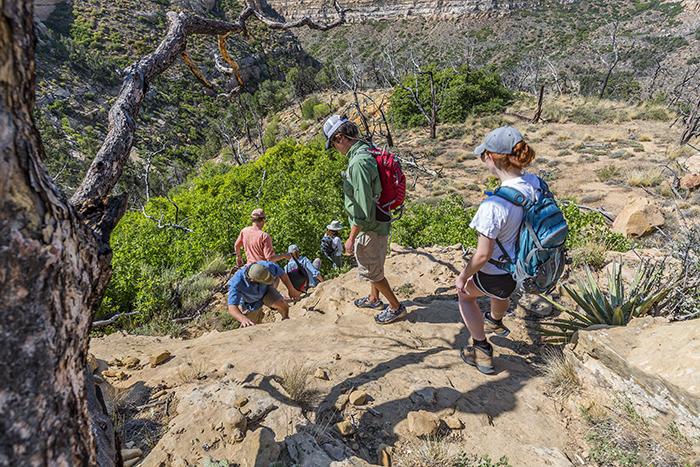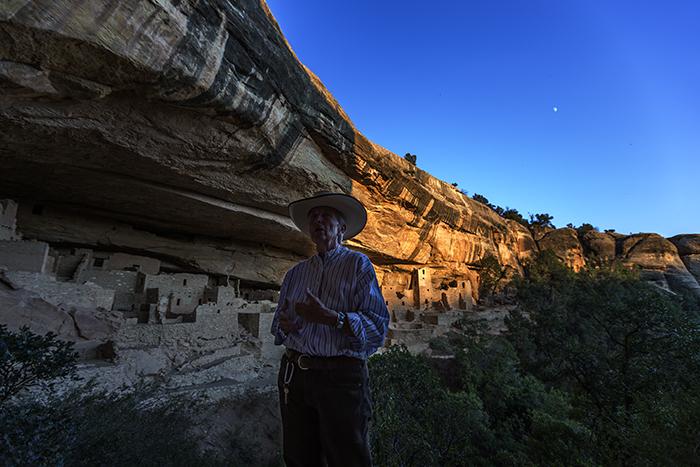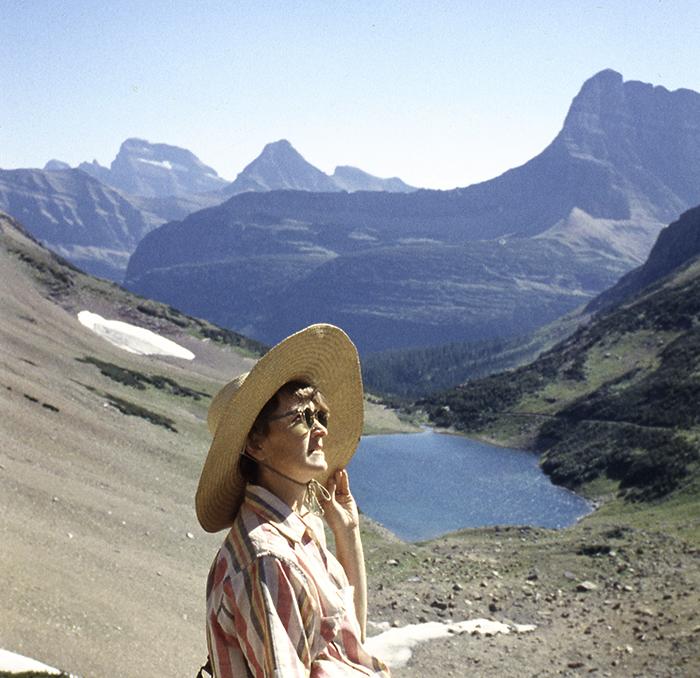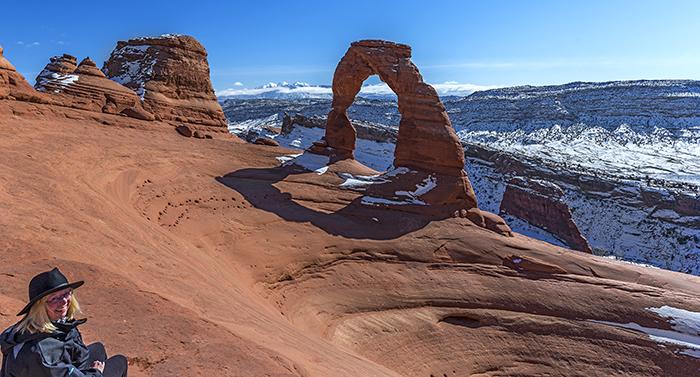
Hiking the Skyline Trail, Mount Rainier National Park / Rebecca Latson
Put people in your precious national park photos? Anathema, right?
Three years ago, I wrote an article for The Traveler dealing with placing people and human-created objects in your national park photos for a sense of scale, reference, and connection. While I don’t want to re-create the wheel with this month’s article, I would like to emphasize the importance of putting a little bit of humanity in some of your images (not all, just some). Try not to roll your eyes just yet.

Hiking the backcountry to Mug House, Mesa Verde National Park / Rebecca Latson

Along the trail toward Cliff Palace, Mesa Verde National Park / Rebecca Latson
Every year, I purchase a national parks annual pass. I look at the image the National Park Service has chosen for that pass, selected from thousands of entries submitted to the Share the Experience photo contest. I also look at the images of the other NPS annual passes (4th Grade Pass, Access Pass, Senior Pass). To be honest, the images that most catch my attention on these park passes are the ones with people in them! This makes sense to me, actually. The Park Service wants people to come see and enjoy the national parks. What better way to entice a visitor than to show pictures of people experiencing nature at its best and having fun and adventure in a national park? Yes, landscapes and wildlife images are fantastic, but those national park passes are pretty small, you know. To see all of the detail in a landscape on that credit card-sized plastic takes a little bit of perusal on one’s part. You may really only glance at the pass rather than take time to fully look at the composition. You know it’s pretty, you get the gist of what the landscape represents, and that’s it. Put a person in that landscape, though, and you might look at that image just a little bit longer. What is that person (or what are those people) doing and looking at?

Demonstrating the use of the mano and metate at Balcony House, Mesa Verde National Park / Rebecca Latson

The guide on the Cliff Palace Twilight Tour, Mesa Verde National Park / Rebecca Latson
You might want to add some humanity to the photos you capture during any sort of ranger- or volunteer-guided tour, like the ones offered at Mesa Verde National Park. Why? Well, during the Balcony House Tour at Mesa Verde, the ranger demonstrated the ancestral Puebloans’ use of the stone mano and metate to grind corn or to grind pigment for paint. The image of the demonstration enhances the verbal description to offer a more comprehensive account of a process. Remember, photography tells a story.
Yet another reason to put humanity in your photos is to keep your audience from becoming bored with looking at all of your national park vacation pics. C’mon. You know it’s true. No matter how gorgeous your images may be, the majority of people viewing your photos for any length of time are probably not going to be photographers consumed with questions regarding the camera settings you used for that sunrise, sunset, or landscape shot. Yes, I was always interested in looking at my friends’ national park trip slideshows (back in the film days), but I do also remember the people around me start to fiddle and fidget, their eyes getting a little glazed after about the seventh slide … until a shot popped up in the slide carousel sporting a family member or friend. Interest revived. Funny stories would be told along with quips about that particular photo. From all of that would emerge a story of a national park experience. Once again, photography tells a story simply by the addition of people.

My mother along the Hidden Lake Trail, Glacier National Park / Rebecca Latson
Humanity can even be limited to just your immediate family members who are accompanying you on your national park trip. I love it that my father captured photos of my family (before and after my birth) during their trips to Banff National Park, Jasper National Park, Glacier National Park, and Grand Canyon National Park. It’s wonderful to listen to my sister reminisce about a particular national park trip or special venue within the park that she and the rest of our family visited so many decades ago. My sister’s grandchildren adore looking at photos with “Grammy” in them when she was so young, and they ask all sorts of questions about that individual image. National park photos with family and friends captured in the composition become a part of family history as well as park history.
Speaking of history, I've been reading Landscapes for the People by Ren and Helen Davis about George Alexander Grant, the first chief photographer of the NPS. A review of this book was written for the Traveler by John Miles. I was so interested after reading Mr. Miles' review that I had to order the book for myself. Of the many wonderful landscape images Mr. Grant captured between 1929 and 1954, my favorites are the ones containing people, vehicles and/or buildings incorporated into Mr. Grant's compositions. It's fascinating to see the old cars and the women in their stylish dresses (and heels!) and the men in their hiking outfits with tall boots and ties (when not in heels, the women wore the same uniform) as they view the wonders of the national park system. I'm looking at history in monochrome! If you ever get hold of a copy, check out photo #96 - having a fear of heights, I got a little touch of vertigo looking at where the gentleman in the photo stood.
Because I almost always travel solo, humanity in my national park compositions usually comes in the form of a self-portrait (aka “selfie”). Not that I need to defend myself to any of you, but there is absolutely nothing wrong with a selfie. You are not being a narcissist if you want a self-portrait. It is a reminder to yourself of what a great time you had in that particular national park, in that particular location. A selfie says you were there. A selfie helps you remember what it was like and how it felt during that specific moment. Most of you also know a selfie makes a great Facebook and Twitter profile pic and, OK, I'll be honest, a selfie is a nice method of bragging to others about the adventures you had while traveling within a national park.

Becky and the volcano, Hawai'i Volcanoes National Park / Rebecca Latson

Becky on the Balcony House Tour, Mesa Verde National Park / Rebecca Latson

Becky at Athabasca Glacier, Jasper National Park / Rebecca Latson

Becky at Delicate Arch, Arches National Park / Rebecca Latson
It’s nice to be flexible with your photographic techniques, you know. You learn from being flexible. Including a little humanity in some of your national park photos will add interest, not only for that portion of the population that enjoys viewing people in images, but maybe also for that other portion of the population that had heretofore never realized how a dash of humanity to a photo might be a great asset for a little extra attention to that national park image.

Visitors during a late afternoon tour of Cliff Palace, Mesa Verde National Park / Rebecca Latson




 Support Essential Coverage of Essential Places
Support Essential Coverage of Essential Places






